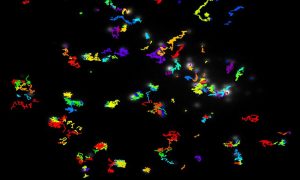ANOMALOUS DIFFUSION
ANOMALOUS DIFFUSION, AGEING AND ERGODICITY BREAKING IN LIVE CELLS
Cells are extremely crowded environments where proteins and lipids move in the presence of mobile and immobile obstacles. Furthermore, membrane and intracellular components often interact with binding partners. We are exploring the dynamics of native molecules and inert nanoparticles in the environment of live mammalian cells. We analyze individual trajectories in terms of the time- and ensemble-averaged mean square displacements. Our results often revealed that molecules experience anomalous subdiffusion with a diffusion pattern that is not ergodic, that is the ensemble and temporal distributions of displacements are different. The dynamics can be usually modeled by the combination of a nonergodic continuous time random walk (CTRW) and an obstructed environment.

- Weigel et al. “Ergodic and nonergodic processes coexist in the plasma membrane as observed by single molecule tracking”, PNAS 108, 6438 (2011)
- Weigel et al. “Obstructed diffusion propagator analysis for single particle tracking”, Phys. Rev. E 85, 041924 (2012)
- Krapf, “Mechanisms underlying anomalous diffusion in the plasma membrane”, Current Topics in Membranes 75, 167 (2015)
- Weron et al. “Ergodicity breaking on the neuronal surface emerges from random switching between diffusive states”, Sci. Rep. 7, 5404 (2017)
- Sikora et al., “Elucidating distinct ion channel populations on the surface of hippocampal neurons via single-particle tracking recurrence analysis”, Phys. Rev. E 96, 062404 (2017)
- Krapf and Metzler, “Strange interfacial molecular dynamics”, Physics Today 72, 9, 48 (2019)
SOLID-LIQUID INTERFACES
Diffusion at solid–liquid interfaces is crucial in many technological and biophysical processes. Although its behavior seems to be deceivingly simple, recent studies showing passive superdiffusive transport suggest that diffusion on surfaces may hide rich complexities. In particular, bulk-mediated diffusion occurs when molecules are transiently released from the surface to perform three-dimensional excursions into the liquid bulk. This phenomenon bears the dichotomy where a molecule always return to the surface but the mean jump length is infinite.
- Campagnola et al., “Superdiffusive motion of membrane-targeting C2 domains”, Sci. Rep. 5, 17721 (2015)
- Krapf et al. “Strange kinetics of bulk-mediated diffusion on lipid bilayers”, Phys. Chem. Chem. Phys. 18, 12633 (2016)
- Hedayati, Kipper, and Krapf, “Anomalous protein kinetics on low-fouling surfaces”, Phys. Chem. Chem. Phys. 22, 5264 (2020)
- Hedayati, Krapf, and Kipper, “Dynamics of long-term protein aggregation on low-fouling surfaces”, J. Colloid Interface Sci. 589, 356 (2021)
DIFFUSION IN THE CYTOPLASM
We study the motion of individual semiconductor nanocrystals that were introduced into the cytoplasm of HeLa cells. Statistical analyses of these trajectories reveal subdiffusion with antipersistent increments and substantial heterogeneities. Furthermore, particles randomly switch between different mobility states, which can be dissected using a hidden Markov model. Our data indicate that one of these states is rooted in the transient associations with the cytoskeleton-shaken endoplasmic reticulum network.
- Sabri et al., “Elucidating the origin of heterogeneous anomalous diffusion in the cytoplasm of mammalian cells”, Phys. Rev. Lett. 125, 058101 (2020)
- Janczura et al., “Identifying heterogeneous diffusion states in the cytoplasm by a hidden Markov model”, New J. Phys. 23, 053018 (2021)
- Dieball et al., “Scattering fingerprints of two-state dynamics”, New. J. Phys. 24, 023004 (2022)

Krapf Lab © 2018